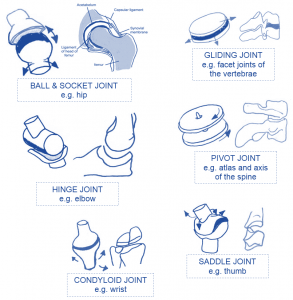Sub-classification of synovial joints
There are several types of synovial joint. Each differs depending on the shapes of the articular surfaces and the movements that are allowed. There are six types of synovial joint:
- Hinge joints: these are uni-axial (only allow movement in one plane, the sagittal – flexion and extension). These consist of convex and concave surfaces fitting together, and strong ligaments exist in order to prevent any sideways movement. Examples include the knee and elbow joints, which only allow the movements of bending and straightening to occur.
- Ball and socket joints: these joints allow the widest range of movement, and permit side to side, back and forth and rotational movements (tri-axial – flexion and extension, abduction and adduction, rotation, circumduction – sagittal, frontal and transverse planes). They occur in the body where a rounded head of a bone fits into a cup-shaped hollow. Examples include the hip and shoulder. The head of the femur/humerus fits neatly into the cavity in the pelvis/scapula, and is held in place by ligaments. The shoulder joint is the weaker of the two as it has a much shallower socket.
- Pivot joints: these joints consist of a ring shaped bone surrounding a cone shaped bone. These are also uni-axial. They only allow rotation to take place (transverse plane). For example, when the axis rotates on the atlas (cervical vertebrae), and the radio-ulnar joint below the elbow.
- Condyloid joints: this type of joint is basically a modified ball and socket joint. These are bi-axial (allow movements in two planes – flexion and extension, abduction and adduction, giving circumduction – sagittal and frontal planes). These joints, however, do not permit rotation. For example the radio-carpal joint of the wrist allows back and forth, as well as side to side movements, and between the metacarpals and the phalanges – the metacarpophalangeal joints (between the fingers and the palm).
- Gliding joints: these are formed where flat surfaces glide or slide past one another, but are restricted to limited movement by the ligaments. They are usually bi-axial, but may permit movement in all directions. Examples include the carpal bones in the wrist, or the tarsal bones in the foot, where the small bones move against each other. Other examples are between the ribs and the thoracic vertebrae, and the joint between the clavicle and sternum.
- Saddle joint: this is bi-axial (flexion and extension, abduction and adduction, giving circumduction – sagittal and frontal plane) and occurs where concave and convex surfaces meet – the joint is shaped like a saddle. It allows side to side and back and forth movements, but not rotation. An example of this joint would be the carpo-metacarpal joint of the thumb. It is this joint that allows the thumb to be placed across the palm (known as opposition).
It is extremely important that all movements at all joints are kept in the correct planes throughout exercise performance for prevention of ligament strain and potential risk of injury.

